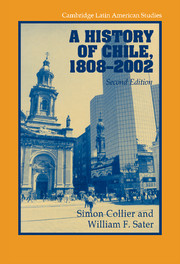Book contents
- Frontmatter
- Contents
- List of maps
- Preface to the Second Edition
- A note on geography
- CAMBRIDGE LATIN AMERICAN STUDIES
- PART I Birth of a nation-state, 1800s–1830s
- PART II The rise of a republic, 1830s–1880s
- 4 A time of progress, 1830s–1870s
- 5 The Liberal impulse, 1841–76
- 6 Crisis and war, 1876–83
- PART III The nitrate era, 1880s–1930s
- PART IV Industrial advance and the dawn of mass politics, 1930s–1960s
- PART V Democracy and dictatorship, 1960s–2000s
- Glossary of Spanish terms
- Initials and acronyms
- Further reading
- Index
4 - A time of progress, 1830s–1870s
Published online by Cambridge University Press: 05 June 2012
- Frontmatter
- Contents
- List of maps
- Preface to the Second Edition
- A note on geography
- CAMBRIDGE LATIN AMERICAN STUDIES
- PART I Birth of a nation-state, 1800s–1830s
- PART II The rise of a republic, 1830s–1880s
- 4 A time of progress, 1830s–1870s
- 5 The Liberal impulse, 1841–76
- 6 Crisis and war, 1876–83
- PART III The nitrate era, 1880s–1930s
- PART IV Industrial advance and the dawn of mass politics, 1930s–1960s
- PART V Democracy and dictatorship, 1960s–2000s
- Glossary of Spanish terms
- Initials and acronyms
- Further reading
- Index
Summary
Everyone is shouting that Chile is the model republic of South America. What on earth can the others be like?
– El Copiapino, No. 3021, June 5, 1858Bulnes was the second president to serve a full ten years. He was followed by two more, Manuel Montt (1851–61) and José Joaquín Pérez (1861–71). During these years, as we shall see in Chapter 5, the peace was twice disturbed by armed rebellion, but for most of the time settled conditions prevailed, and the country enjoyed noticeable commercial expansion. Steamships appeared in the ports, railroads inched across the northern desert and the Central Valley, telegraph wires linked the towns, banks and joint-stock companies were founded, and cities were improved. Educated Chileans saw this as a time of progress. This key nineteenth-century concept was fully assimilated by the country's leaders and opinion-formers. Santiago's first daily newspaper was called El Progreso: over the next hundred years this was the most popular title for newly founded Chilean newspapers. In retrospect, the period of the “early republic” can also be seen as a distinct economic cycle, as the products of the mines and haciendas flowed to the outside world. Only with the crisis of the 1870s was this phase of export-led expansion exhausted.
- Type
- Chapter
- Information
- A History of Chile, 1808–2002 , pp. 73 - 103Publisher: Cambridge University PressPrint publication year: 2004

